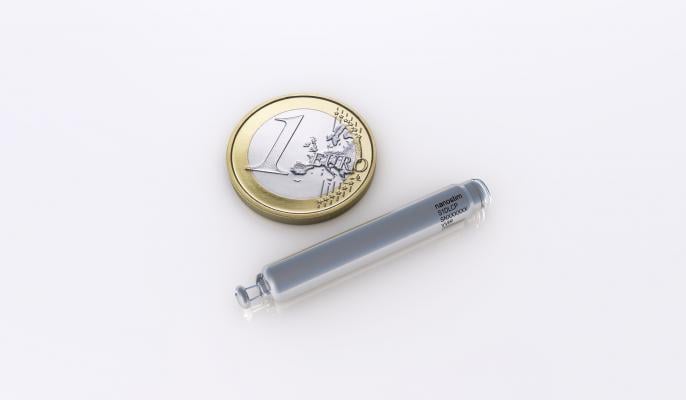October 14, 2013 — St. Jude Medical Inc. announced the completion of its acquisition of Nanostim Inc., developer of a miniaturized, leadless pacemaker, and that the device received CE mark clearance in Europe.
The Nanostim leadless pacemaker is less than 10 percent the size of a conventional pacemaker. The small size of the device and lack of a surgical pocket, coupled with the exclusion of a lead, improves patient comfort and can reduce complications, including device pocket-related infection and lead failure. The elimination of the visible lump and scar at a conventional pacemaker’s implant site, in addition to the removal of patient activity restrictions that may prevent the dislodgement or damage to a conventional lead, will potentially improve the quality of life for patients with this technology by allowing most to continue living active, uninhibited lifestyles.
The acquisition adds the world’s first and only leadless pacemaker to the St. Jude Medical product portfolio and culminates a two-year partnership between the two companies, during which St. Jude Medical invested in and collaborated with Nanostim throughout its product development and commercialization initiatives.
Unlike conventional
pacemakers that require a more invasive surgery, the Nanostim leadless pacemaker is designed to be implanted directly into the heart via a minimally invasive procedure. The device is delivered using a steerable catheter through the femoral vein, eliminating the need to surgically create a pocket for the pacemaker and lead wires that have historically been recognized as the most vulnerable component of pacing systems.
St. Jude said the Nanostim recently received U.S. Food and Drug Administration (FDA) conditional approval for its investigational device exemption (IDE) application and pivotal clinical trial protocol. The IDE trial will evaluate the Nanostim leadless technology in U.S. patients.
“The Nanostim leadless pacemaker represents one of the most important advances in the history of pacing technology, and builds on St. Jude Medical’s strong history of pacing innovation — beginning with the first implantable pacemaker in 1958 through the introduction of quadripolar cardiac resynchronization therapy pacing,” said Eric S. Fain, M.D., president of the St. Jude Medical implantable electronic systems division. “We look forward to welcoming Nanostim employees to St. Jude Medical and to continuing our legacy of transforming the treatment of cardiac rhythm disorders with pioneering technology.”
The device is supported by the St. Jude Medical Merlin Programmer that is also used to interrogate and program the company’s other pacemakers and implantable cardioverter defibrillators (ICDs).
“For the past 40 years the therapeutic promise of leadless pacing has been discussed, but until now, no one has been able to overcome the technical challenges,” said Dr. Johannes Sperzel of the Kerckhoff Klinik in Bad Nauheim, Germany. “This revolutionary technology offers my patients a safe, minimally-invasive option for pacemaker delivery that eliminates leads and surgical pockets. This is the future of cardiac pacing.”
Device is Retrievable, Offers Nine-year Battery Life
The Nanostim leadless pacemaker was designed to be fully retrievable so that the device can be readily repositioned during the implant procedure and later retrieved if necessary, such as at the time of normal battery replacement. Initial results from the LEADLESS study, a prospective, single-arm, multicenter study evaluating patients with the Nanostim leadless pacemaker, were presented earlier this year and demonstrated overall device performance comparable to conventional pacemakers. Total implant procedure times averaged 28 minutes. Even with miniaturization, the device battery is expected to have an average lifespan of more than nine years at 100 percent pacing, or more than 13 years at 50 percent pacing.
Cardiac pacemakers are used to treat slow bradycardia heart rates. More than 4 million people worldwide have an implanted pacemaker or other cardiac rhythm management device, and an additional 700,000 patients receive the devices each year.
Transaction Details
On May 3, 2011, St. Jude Medical and Nanostim entered into a series of agreements pursuant to which St. Jude Medical made an investment in, and obtained an exclusive option to acquire, Nanostim. This transaction results from St. Jude Medical’s exercise of its exclusive option under those agreements. Under the terms of a merger agreement entered into between the parties, St. Jude Medical paid $123.5 million to Nanostim shareholders at the closing of the transaction.
The merger agreement also provides for additional cash payments of up to $65 million, which are contingent upon both the achievement and timing of certain revenue-based milestones. Except for acquisition-related expenses, this transaction does not impact St. Jude Medical’s outlook for 2013 consolidated earnings per share.
Commenting on the acquisition,
“Nanostim’s focus on bringing innovative technologies to the market closely aligns with St. Jude Medical’s commitment to developing leading products and treatment options for patients and physicians worldwide,” said Nanostim CEO Drew Hoffman. “We are pleased to have recently received CE mark approval for the Nanostim leadless pacemaker. Nanostim looks forward to now working as part of St. Jude Medical to further advance our commercialization initiatives and expand this technology into new and existing markets.”
In connection with this transaction, BofA Merrill Lynch is acting as financial advisor and Gibson, Dunn & Crutcher LLP as legal advisors to St. Jude Medical. Wilson Sonsini Goodrich & Rosati is acting as legal counsel to Nanostim.
Nanostim, an early-stage medical device start-up company based in Milpitas, Calif., is also backed by InterWest Partners, US Venture Partners, Emergent Medical Partners and Life Science Angels.
For more information: www.sjm.com

